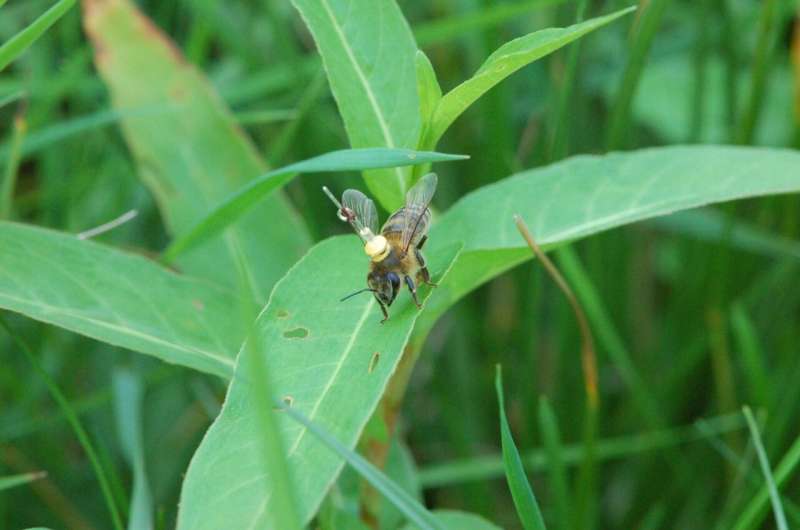This article has been reviewed according to Science X's editorial process and policies. Editors have highlighted the following attributes while ensuring the content's credibility:
fact-checked
peer-reviewed publication
proofread
Bees follow linear landmarks to find their way home, just like the first pilots

Scientists have shown that honeybees retain a memory of the dominant linear landscape elements in their home area like channels, roads, and boundaries. When transported to an unfamiliar area, they seek out local elements of this kind, compare their layout to the memory, and fly along them to seek their way home. This navigation strategy is similar to the one followed by the first human pilots.
In the earliest days of human flight, before the invention of the first radio beacons and ground-based electronic systems, and modern GPS, pilots commonly navigated by following roads and railways—striking linear landscape elements at ground level that guide towards a destination of interest.
Enter the honeybee. A century of research has shown that honeybees are navigators par excellence. They can navigate by their sense of smell, the sun, the sky's pattern of polarized light, vertical landmarks that stand out from the panorama, and possibly the Earth's magnetic field. They are also clever learners, able to recognize associations between disparate memories in order to generalize rules.
Now, scientists have shown that honeybees tend to search for their way home by orienting themselves in relation to the dominant linear landscape elements, just like the first pilots. The results are shown in Frontiers in Behavioral Neuroscience.
Dr. Randolf Menzel, an emeritus professor at the Department of Neurobiology of the Free University of Berlin, and the study's lead author, explained, "Here we show that honeybees use a 'navigation memory', a kind of mental map of the area that they know, to guide their search flights when they look for their hive starting in a new, unexplored area. Linear landscape elements, such as water channels, roads, and field edges, appear to be important components of this navigation memory."
Tiny transponder
In late summer of 2010 and 2011 near the village of Klein Lüben in Brandenburg, Menzel and colleagues caught 50 experienced forager honeybees and glued a 10.5-mg transponder on their back. They then released them in a new test area, too distant to be familiar to the bees. In the the test area was a radar, which could detect the transponders at a distance of up to 900 meters. The most notable landmark in the test area was a pair of parallel irrigation channels, running southwest to northeast.
When honeybees find themselves in unfamiliar territory, they fly in exploratory loops in different directions and over different distances, centered on the release spot. With the radar, the researchers tracked the exact exploratory flight pattern of each bee for between 20 minutes and three hours. The bees flew at up to nine meters above the ground during the experiment.
The researchers had collected foragers from five hives: the home area around hives A and B resembled the test area in terms of the number, width, length, and angle of linear landscape elements, especially irrigation channels. The home range around hives D and E was highly dissimilar in this regard, while the home area around hive C was intermediate in similarity to the test area. Other landmarks by which honeybees are known to find their way, such as structured horizons or vertical elements that stand out, were absent in the test area.
Non-random search pattern
Menzel et al. first simulated two sets of random flight patterns, centered on the release spot, and generated with different algorithms. Since the observed flight patterns were highly different from these, the researchers concluded that the honeybees didn't simply conduct random search flights.
The researchers then used advanced statistics to analyze the orientation of flights and their frequency of flying over of each 100 x 100 meter block within the test area. They showed that the honeybees spent a disproportionate amount of time flying alongside the irrigation channels. Analyses showed that these continued to guide the exploratory flights even when the bees were more than 30 meters away, the maximum distance from which honeybees are able to see such landscape elements. This implies that the bees kept them in their memory for prolonged periods.
"Our data show that similarities and differences in the layout of the linear landscape elements between their home area and the new area are used by the bees to explore where their hive might be," said Menzel.
Navigational memory
Importantly, machine learning algorithms showed that the irrigation channels in the test area were most informative for predicting the exploratory flights of bees from hives A and B, less so for bees from hive C, and least for bees from hives D and E. This suggests that the bees retained a navigational memory of their home area, based on linear landscape elements, and tried to generalize what they saw in the test area to his memory to find their way home.
"Flying animals identify such extended ground structures in a map-like aerial view making them highly attractive as guiding structures. It is thus not surprising that both bats and birds use linear landmarks for navigation. Based on the data reported here we conclude that elongated ground structures are also salient components of the honeybees' navigation memory," concluded the authors.
More information: Generalization of Navigation Memory in Honeybees. Frontiers in Behavioral Neuroscience (2023). DOI: 10.3389/fnbeh.2023.1070957. www.frontiersin.org/articles/1 … eh.2023.1070957/full
Journal information: Frontiers in Behavioral Neuroscience
Provided by University of Berlin




















